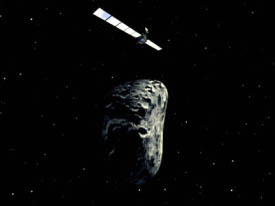Much can be learned from a close look at an asteroid, as the European Space Agency’s Rosetta spacecraft will demonstrate this September. For one thing, interactions between the solar wind and the asteroid can deepen our knowledge both of the object and the forces that act upon it. For another, studying what’s around the asteroid can be useful, especially now that we know some asteroids have even smaller asteroid ‘moons.’

But Rosetta’s September target, asteroid (2867) Steins, is an interesting case in and of itself. E-type asteroids, which this one is, are relatively common in regions closer to the Sun but uncommon within the main belt itself. They’re typically small and show a high albedo, reflecting more light from the Sun than the average asteroid. Moreover, while they’re apparently made of silicates and basalts, their composition is only poorly understood. Thus the choice of (2867) Steins as a target within a larger mission plan that culminates in 2014 at comet 67/P Churyumov-Gerasimenko. A flyby of asteroid 21 Lutetia (in 2010) is also scheduled along the way.
Image: Rosetta goes into passive cruise mode on the way to the asteroid belt. It observes the asteroids from a distance of a few thousand kilometres. Data recorded on board is transmitted to Earth after the fly-by. Credits: ESA/AOES Medialab
This is a mission marked by gravity assists, with three close passes by the Earth (the third scheduled for November of next year) and one by Mars. The news from ESA is that the spacecraft has been successfully awakened from the hibernation mode it entered in March and will now undergo extensive equipment checking while tracking Steins with its on-board cameras to tighten up our knowledge of the asteroid’s orbit. The September flyby will take Rosetta within a distance of 800 kilometers of the asteroid, passing it at 8.6 kilometers per second.
We may have a long way to go until arriving at Churyumov-Gerasimenko, but keep your eye on this ambitious mission as it proceeds. Rosetta’s orbiter will release a lander onto the comet’s nucleus and will spend two years orbiting it as the comet moves toward the Sun. We can hope for abundant data on how the cometary nucleus changes with rising temperatures, while the lander will give us our first images from a comet’s surface and first analysis of its materials from the actual site.
Behind all of that is the ever simmering astrobiological question. We know that comets contain compounds rich in carbon, hydrogen, oxygen and nitrogen, complex organics that are also the stuff from which nucleic acids and amino acids are made. The possibility of comets playing a role in seeding life on Earth continues to be provocative. Ancient cometary materials take us back to an era before the formation of the planets, so Rosetta’s studies of evaporating ices, dust and gas particles around Churyumov-Gerasimenko could prove fruitful indeed.


Rosetta starts tracking asteroid Steins
4 August 2008
Heading toward its first target-asteroid, (2867) Steins, ESA’s
Rosetta spacecraft has started using its cameras to visually
track the asteroid and eventually determine its orbit with more
accuracy.
http://www.esa.int/esaCP/SEMF0B8N9JF_index_0.html
Perfect sight: Rosetta tracks asteroid target
18 August 2008
On 14 August, Rosetta conducted a successful trajectory correction
manoeuvre using data obtained from the Agency’s first-ever optical
tracking of an asteroid target, (2867) Steins. Images from the
spacecraft’s cameras were used to calculate the asteroid’s location
and optimise its trajectory for fly-by next month.
Rosetta’s first major correction manoeuvre in the approach phase took
place while the spacecraft was just less than 17 million km from
Steins. The spacecraft’s thrusters burned continuously for
approximately 2 minutes, starting at 13:42 CEST (Central European
Summer Time). This achieved a change in Rosetta’s speed with respect
to Steins of 12.8 cm/sec.
Full article and images can be found at:
http://www.esa.int/SPECIALS/Rosetta/SEMC9R6UWJF_0.html